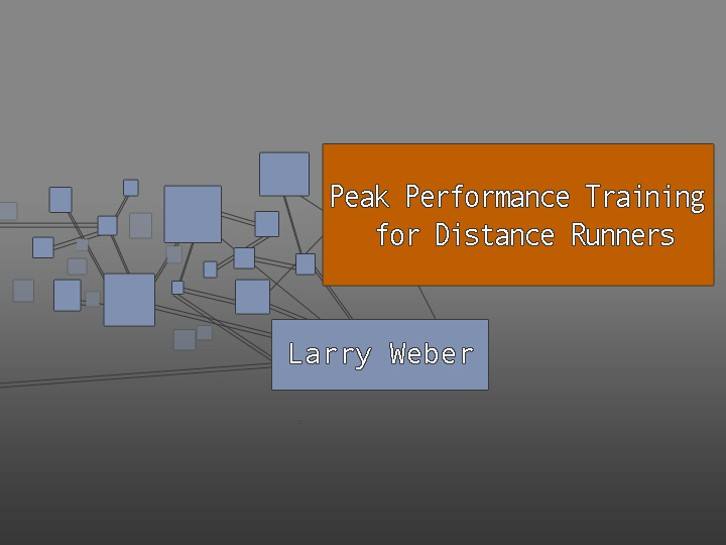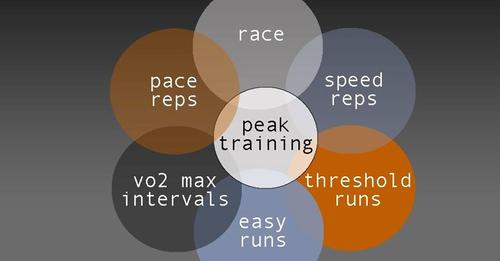Peak Performance For Mid-And Long Distance Runners

Key Ideas
1. Learn the primary zones for training
2. Understand the general heart rate level and recovery periods in each training zone
I designed the graphic at the bottom of the page to illustrate the interrelationships between the vital training strategies and zones for mid and long-distance runners.
Peak performance requires that you perform each training session at the proper time and pace during the training cycle.
Staying within the proper training zones will help you run a personal best. Each type of training pace has a specific benefit/purpose in the season training cycle.
The zone illustrations are general for educational purposes. It is essential to understand the primary impacts of each training zone before talking about the exceptions.
I am fully aware of other research that indicates some cross-over physiological benefits between each zone (you can get multiple physiological benefits from training in a zone), but that is not the purpose of this post. I am starting with the primary benefits and workouts of each zone first.
The definitions of each critical training zone are outlined below.
Easy Runs
Easy runs build a base for more complex and difficult training. Running at a leisurely pace strengthens the heart and increases the muscle’s ability to utilize oxygen. Think of easy runs as laying the foundation for your running house.
Generally, easy runs are at 60-79% of the maximum heart rate. Each week, your one long run is up to 25% of your total mileage.
Easy runs also help you warm up for strenuous workouts and warm down after a workout. An easy run after a hard workout helps you recover faster and reduces the chance of injury as well.
Tempo/Threshold Runs
Threshold pace (also called tempo runs) are run at a rate that feels comfortably hard. Running at this pace improves your lactate threshold. This type of training helps you hold a faster pace for a more extended period. A rapid pace for a more extended period is mission-critical to any runner’s success.
Running at about 82-88% of your maximum heart rate improves your lactate threshold level. Generally speaking, most threshold/tempo runs are about 20 minutes for high school athletes or about 10% of their weekly mileage (after the student-athletes build up to this level over several weeks).
College and elite athletes sometimes run much further in their tempo runs, depending on their age and experience.
VO2Max Intervals
VO2max intervals help increase the maximum amount of oxygen you can use during a specific duration of intense exercise.
Having more oxygen when you run fast is a good thing. The more oxygen you can utilize during intense exercise, the quicker you can run.
Your heart rate is about 97-100% of its maximum during VO2max training sessions. To reach the desired physiological response, the rest between each repetition is equal to or less than the duration of the repetition.
For example, if the pace for a 6x 800-meter workout is 3:00 minutes for each 800 you run, then your jog rest period would be 3:00 minutes or less before attempting the next repetition.
For best results, the duration of each repetition is between 3-5 minutes.
About 8%-10% of weekly training miles are run at VO2max pace once the conditioning/base period (easy runs) and some light speed or hill training is completed.
If you are running in the VO2max zone, you cannot talk while you run. All of your energy is focused on running fast.
Pace Reps/Speed Reps
Pace reps, also called repetition running, help to improve running economy (efficiency) and speed. Typical distances run are 200 meters, 300 meters, or 400 meters.
Generally, you run pace reps at your current mile race pace early in the season. Speed reps are run faster than the current mile race pace later in the season.
For example, if a runner has a current mile best of 5:00 in a recent race, his current mile pace is about 75 seconds for each 400. Therefore, a runner might run 10 x400 meters at this pace early in the season.
Toward the end of the season, however, this same runner will run faster than the current race pace (speed reps), say 6x 400 meters at 68-70 seconds, to improve his speed.
The volume of the work decreases from 10x 400 to 6x 400. However, the pace picks up. Running faster speed reps is likely to drop the runner’s time in this example to under 5:00 minutes in the mile.
There is full recovery when you run pace reps. Complete recovery typically takes between 2 and 4 minutes after each fast repetition.
The point of these shorter runs is to learn how to run fast with good mechanics. You have to take quite a bit of rest to run pace and speed reps multiple times in a workout.
No more than 5% of weekly miles are run at or faster than the current mile race pace.
Other Zones
There are other training zones like marathon pace (some coaches call this steady-state running) and the “roll-on recovery pace (where the training effect happens mostly during the faster than normal recovery pace)” between hard repetition workouts that are effective training strategies.
I will talk more about the value of these training zones in a future post. In addition, I will share the most recent research, which is improving our understanding and benefits of training zones.
Blessings,
Coach Weber
Philippians 4:13
Note: The information above is for general education purposes only. Each runner needs a customized plan to reach their potential. Some runners can train more than what is outlined in this post. Some have to train much less.
